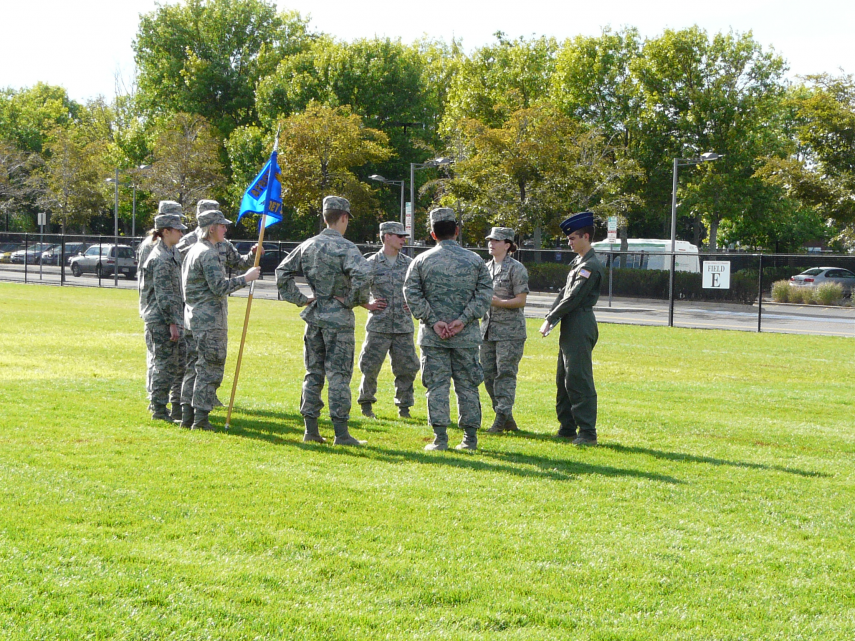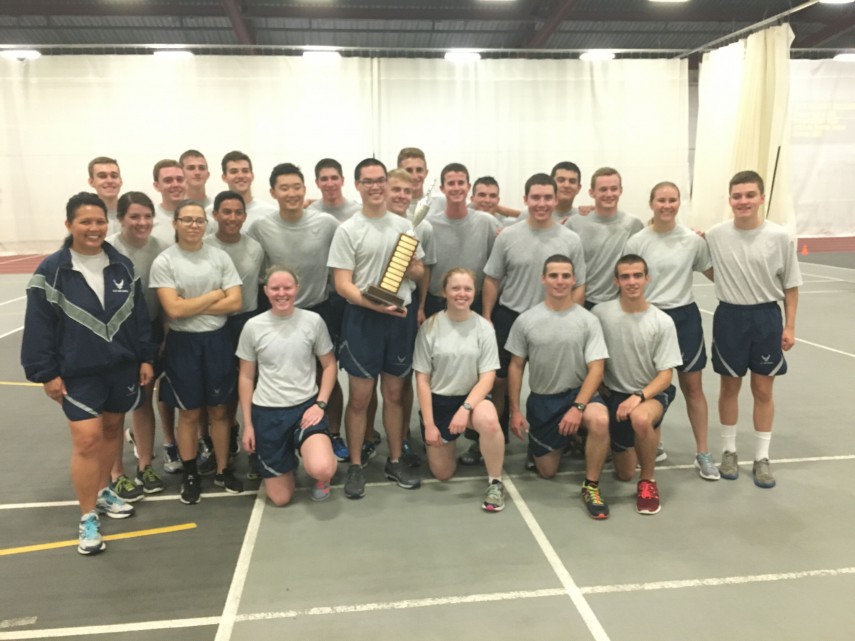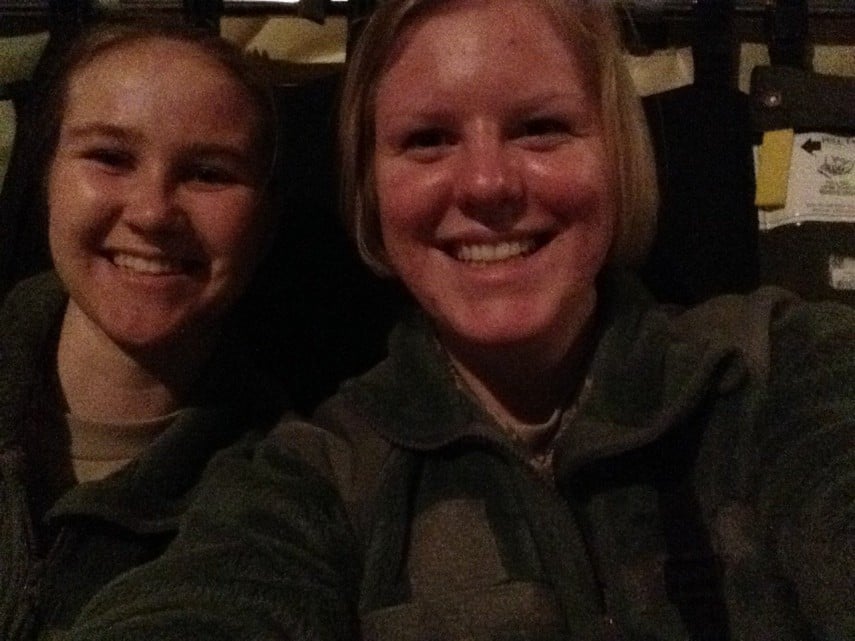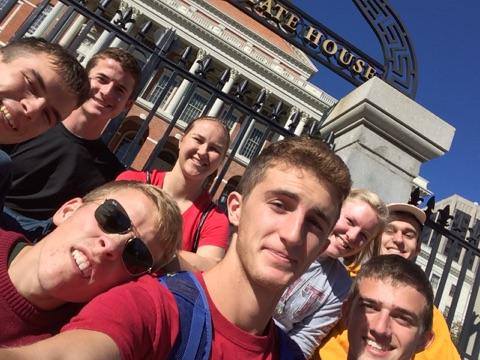ROTC Is Life (In a Good Way) by Selam G. '18
Everything you ever wanted to know about ROTC at MIT (and then some)
Hello everyone!
The following was written by a couple friends of mine who are in ROTC, the Reserve Officer Training Corps. Tessa and Rachel, who I lived with in Simmons during freshman year, are in the ROTC program at MIT, and I myself got to know the program a little as their friend and as a friend of other ROTC members. Something interesting I realized at the end of fall semester was that actually, all the ROTC members I know personally are women, and they all find the program a fulfilling part of their MIT experience. I had not known about ROTC at all before I came to MIT (not even as something done at other schools), but after learning about it from my friends, I thought it would have been a great option for anyone adMITted who wanted to consider it (and now, a good number of you have been!) We hope to let you know a little more about the program through this blog post.
Hi, I’m Tessa W. ‘18. I’m studying Chemical Engineering ( Course 10), and I’m an Air Force ROTC Cadet 3rd Class.
Howdy, I’m Rachel P. ‘18. I’m doing Course 16 (Aeronautics and Astronautics) and I’m also an Air Force ROTC Cadet 3rd Class.
ROTC is a really interesting program with a lot of cool opportunities (obviously, we’re a little biased), and we get a lot of questions about the program, typically on the days when we wear our uniforms. So here are our answers to some of the most common questions we hear, and a few others that we think are relevant.
Tessa is adjusting Rachel’s uniform before inspection on the left photo. In the right photo, Rachel is on the left and Tessa is on the right, excited for an incentive flight on a KC-135.
1) So… how does this whole thing work?
ROTC is an abbreviation for Reserve Officer Training Corps. It is a training program intended to train students as comissioned officers for the US Armed forces, based in colleges and universities. If you join the program, you participate in four years of ROTC in college (three if you join as a sophomore). When you enter the military (in our case, the Air Force) you enter as the lowest officer rank, instead of enlisting–in other words, you would be in more of a leadership position than those who generally enlist in the military. Officers could be involved in all sorts of things, including positions that could be in your major at MIT or elsewhere–the military has many research labs, designs cutting-edge technology, and invests both people and resources in cyber security. The general service commitment after ROTC is at least four years active duty, and then enough years in the reserve to total eight years. There are certain careers, like being a pilot, that have a longer service commitment because they require more job specific training. And, of course, you’re allowed to stay in longer if you want.
There are dozens of schools with AFROTC (Air Force ROTC) detachments, but if you go to a school that doesn’t have their own detachment, you can still participate in ROTC at another school in the area. Harvard, Tufts, Wellesley, Suffolk, and Salem State all have crosstown agreements with MIT’s detachment, so we have several students in our detachment who actually go to other schools. There are many scholarship opportunities for ROTC cadets, but you don’t have to have a scholarship to enroll in the program. You can find a lot more information about that at afrotc.com/scholarships.
2) Do you actually have a ROTC class?
Indeed we do. During freshman and sophomore year, we have one hour of class in a traditional classroom setting, and two hours of Leadership Laboratory (LLAB). In our regular class, which is called Aerospace Studies (AS for short) (it’s not actually about aerospace), we learn about the Air Force. The specifics change as you progress in the program. Freshman year you cover a lot of introductory material and basic information about the Air Force. Sophomore year is mostly Air Force history. Junior and senior year AS class is slightly longer, and you learn about how doctrine, strategy, and leadership fit together and you prepare for commissioning. LLAB has more hands-on activity, like drill (basic marching), team building exercises, and introductory combat skills. The goal of LLABs varies year to year: freshman year it’s learning, sophomore year it’s preparing for Field Training, and junior and senior year it’s practicing your leadership skills. Juniors and seniors are in charge of actually planning and running LLABs.

When the weather is nice, we usually have LLAB outside. This was our second LLAB of the semester.
3) Do you have to do ROTC things over the summer?
Yes and no. During your sophomore year, you apply for a slot to go to Field Training over the summer, which is about 4 weeks of boot-camp style training (more commonly known as “the best fun you never want to have again”). Every cadet has to successfully complete Field Training in order to commission. In addition, some cadets (depending on their scholarship status) spend two weeks on an Air Force base after freshman year, shadowing officers and getting a better idea of how the Air Force works. With these two exceptions, though, your breaks (Christmas, spring, summer, IAP) are all yours to fill with travel, internships, etc. On the other hand, there are many opportunities to do some cool things through ROTC. I (Rachel) was able to go Bishkek, Kyrgyzstan this summer for an 8-week Russian language immersion program through a program known as Project GO. The program is not limited to Russian, and many of the cadets at our detachment have been able to do similar programs completely funded by ROTC, studying strategic languages such as Russian, Korean, and Swahili. Besides the general excitement of studying abroad in a completely different location, this was a great experience for me since it can be difficult to fit in language classes at MIT with all of your technical classes and other humanities requirements. Though I’ve loved my Russian classes here, being around the language 24/7 is far more effective – you tend to learn the target language really quickly when your host family doesn’t speak a word of English :)
4) So do you work out a lot?
Kind of. We have Physical Training (PT) twice a week on Wednesday and Friday mornings at 0700 (7AM). It lasts an hour, and what we do varies from week to week and day to day. Crosstown cadets (cadets who go to another university but come to MIT for ROTC) and varsity athletes only have to come to one PT session every two weeks, but they have to submit a waiver and still work out outside of PT. To really stay in shape though, you have to work out more than twice a week, so we all work out on our own time as well. If you’re a high schooler applying for a scholarship, you’ll need to take a fitness assessment as part of your application, and if you receive a scholarship, you’re expected to pass a Physical Fitness Assessment (PFA) each semester. Everyone in ROTC regardless of scholarship status still goes to PT and takes the PFA, so it’s in your best interests to get in and stay in shape. For the PFA, the goal is excellence, as our detachment consistently has one of the highest national PFA averages. We were not fully prepared our freshman year, but we are doing much better now, so there’s always hope if you’re not in great shape when you start. If you’re looking for some motivation, I’d recommend this quick workout: https://www.youtube.com/watch?v=41N6bKO-NVI
Or, if you think that’s too easy, find some friends and google “Ranger pushups.”

Once a year, Air Force, Army, and Navy ROTC all get together in the morning and play sports instead of having normal PT. We’re the reigning champions! (Tessa is kneeling at the bottom left and Rachel’s standing one from the right end!)
5) Do you guys ever have fun?
Yes! Mandatory fun!
But seriously, there are a lot of chances to relax with each other outside of class. We’ll go to the movies together, or walk the Freedom Trail as a group, or occasionally go paintballing. We actually just went paintballing a few weeks ago, and it was really fun. ROTC is something where you’ll get out of it what you put into it, so participating in everything you can is beneficial. This is also relevant to building relationships with fellow cadets – because our detachment is on the smaller side, you get to know everyone pretty well when you hang out with the group. And LLAB is generally interesting and makes a nice change from regular academic classes.
This picture is from when the 100s and 200s (freshmen and sophomores) walked the freedom trail together for a retention event (basically bonding). Our selfie game is strong.
6) Do you have any other cool AFROTC experiences?
Actually, yes!
Last year, the entire detachment was fortunate enough to get to ride on a KC-135 (a cool, military aerial refeuling aircraft) during a refueling mission. We took turns watching the refueling and sitting in the cockpit, and it was a really awesome experience. Cadets may also get the chance to ride in a fighter jet (typically an F-15 or F-16), and I (Rachel) did this last year over IAP. It’s way better than any roller coaster you’ve ever been on.
On top of that, last spring break several cadets participated in the Israel Security Seminar and got to experience Israeli culture and learn about the challenges Israel faces. Thanks to MIT and other donors, they spent a week in Israel hiking, touring historical sites, and meeting with panels to discuss various military and cultural topics, for a fraction of what it would normally cost.
Looking for more information? We have a Part II in the works and it will hopefully be up soon! You can also go to afrotc.com for information about AFROTC in general, or http://afrotc.mit.edu if you want to know more about AFROTC at MIT or one of our detachment’s cross-town schools (Harvard, Tufts, Wellesley, Suffolk and Salem State).


